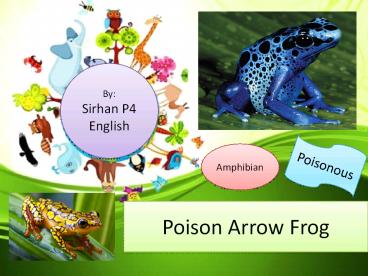Poison Arrow Frog - PowerPoint PPT Presentation
Title:
Poison Arrow Frog
Description:
Fact about Poison Arrow Frog and why they are poisonous? Science and English for Primary – PowerPoint PPT presentation
Number of Views:88
Title: Poison Arrow Frog
1
Poison Arrow Frog
By Sirhan P4 English
Poisonous
Amphibian
2
Animal Description
- Poison arrow frogs are also called poison-dart
frogs because some of the Amerindian tribes use
their secretions to poison their darts. - Not all arrow frogs are deadly, only three
species are very dangerous to humans. - The most deadly species to humans is the
Phylobates terriblis. Arrow frogs are not
poisonous in captivity. - Cutaneous chytridiomycosis was documented for the
first time as a vertebrate parasite. - The same antifungal that is used to kill
athletes foot in humans can be used with the
frogs and toads. - Poison arrow frogs are known for their beautiful
colors. - These colors are used as warnings to predators
that they are poisonous (their poisonous defense
evolved to ward off predators.) - Some scientists think that the reticulated
pattern of the frogs also act as camouflage among
the forest shadows.
3
Habitat Description
- These frogs are found in Columbia along the
western slopes of the Andes. - Poison frogs live in the rainforests of Central
and South America. - auratus is found on the Pacific coast from
southern Costa Rica to northern Columbia and on
the Caribbean coast of southern Nicaragua to
Columbia and the island of Tobago.
4
Food
- Both feed mostly on spiders and small insects
such as ants and termites, which they find on the
forest floor using their excellent vision. - They capture their prey by using their sticky,
retractable tongues. - They are fed small crickets daily.
5
Protection
- They protect themselves by deceive theyre
predator with their beautiful colours. - They use theyre color to remind the predator
that they are poisonous. - Poison dart frogs protect themselves best simply
by being deadly to consume. They are
dendrobatids, part of a family of animals
that includes some of the most toxic
species on the planet.
6
Birthing Process
- The mating season for auratus occurs throughout
the entire rainy season from mid-July through
mid-September. - Male frogs go through an elaborate ritual to
attract mates. The males vocalize, a trill sound,
to attract females. The female lay up to 40 eggs
on leaves. The eggs are encased in a gelatinous
substance for protection against desiccation. - During the two-week development period, the male
returns to the eggs periodically to check on
them. Once the tadpoles hatch, they swim onto the
males back and he carries them to a place
suitable for further development, such as wet
holes in broken trees and branches, little ponds,
wet coconut-shells, and even in tin cans and car
tires. - The tadpoles are attached to the males back by
a mucus secretion, which is soluble only in water
so there is no chance for them to fall off. Once
at their final destination, the tadpoles are on
their own. They need an additional three months
to metamorphose into small frogs.
7
Fascinating or Unique
Characteristic
- Most species of poison dart frogs are small,
sometimes less than 1.5 cm. In adult length,
although a few grow up to 6 cm. - The only animal that can kill with just a touch.
The toxin is not in the tongue or fangs. but in
the skin glands.
8
Problems
- European and American collectors prize the
brightly colored poison dart frogs, resulting in
a high demand in the international pet trade for
new and increasingly rare specimens. - Wild poison dart frogs are protected by treaty,
but that increases their value to smugglers, who
export them illegally to capitalize on the
demand. - Smugglers hide these little frogs in luggage, or
concealed in legal shipments of exported tropical
fish.
9
Conclusion
- I like this animal because the color is beautiful
to see. - I dont like this animal
because it have a toxin and
its poisonous. - I also like this animal
because is small and cute.
10
-Sirhan Zafirah-































